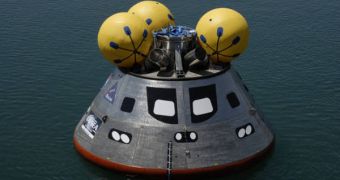The successful completion of the Orion spacecraft is paramount for NASA, on account of the fact that, as soon as it has a working prototype, the shorter the time span it will have to wait until it can resume spaceflights. With the three-shuttle fleet due to be retired at the end of 2010, the Americans find themselves in a very awkward situation, in that they will remain without manned spaceflight capabilities for the first time in more than 50 years. It will be up to the Russians to carry astronauts to the International Space Station, and only RosCosmos and ESA will contribute to lifting cargo and supplies for the future six-member crew aboard the station.
In a bid to avoid having to wait until 2015 to deploy its new Constellation space exploration system, comprised of the Orion capsule and the ARES delivery system, NASA has recently begun water-testing the buoyancy of its capsule, under various conditions. Following the initial test, where the Orion was lowered into a pool and proved that it could stay afloat, experts at the Cape Canaveral Air Force Station now want to experience with methods of improving those abilities after the craft has already “landed.” The tests were performed in the calm waters of the station's Trident Basin.
A mock-up of the 15-foot-diameter craft was lowered into the water and pararescue jumpers attached three yellow inflatable spheres to the top of the craft. In a real-life situation, their role would be to ensure that the capsule sits upright in the water, even if it lands upside down. In such a scenario, the cone-shaped Orion would instantly deploy its inflatable spheres, which would force the tip of the craft out of the water and into its normal position.
During the latest tests, the jumpers also placed inflatable rings around the base of the capsule, in a drill meant to give them the experience they needed to be able to stabilize the craft in a real-life situation. Making Orion sit relatively still in the sea will be paramount for the safe extraction of the crew members from inside the craft's hatch. After the successful completion of the test, NASA Test Director Michael Generale is quoted by Space as saying that sea tests are next. The Exploration Vehicle will continue to undergo testing, under increasingly bad weather conditions, so that engineers can fully assess its behavioral patterns.

 14 DAY TRIAL //
14 DAY TRIAL //